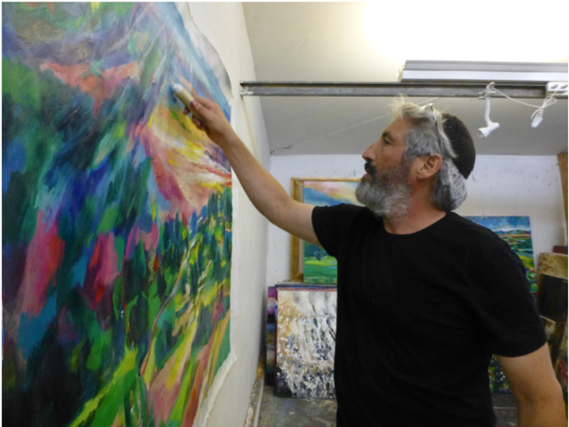The Painter
 Yoram Raanan
Yoram Raanan
Bloomfield, New Jersey
University of Arts, Philadelphia, BFA (1975)
Ohr Somayach Jerusalem 1976-1978
Painter
Lives in Beit Meir, Israel
In the olden days, when Ohr Somayach was young and backpackers were a central component of our student population, Rabbi Meir Shuster, z”l, brought Yoram Raanan (not his name at the time) to the Yeshiva, which was then located at the Mili Building on Rechov Tidhar. He had picked him up “off the wall” and had suggested to the budding artist that he would feel comfortable here. Yoram had been backpacking across Europe and the Middle East. While in Egypt, he and a fellow traveler decided to visit Israel. Like most backpackers, he had a very limited budget and had read in a guidebook that if one wanted a really good and free meal in Israel the place to go was the Kotel Hamaaravi in Jerusalemon a Friday night. Someone was sure to invite you to a tasty Shabbat meal.
Rabbi Shuster approached Yoram that Shabbat evening and invited him to his own apartment. The meal was delicious and the suggestion was made that Yoram might like a free place to stay and free meals with no strings attached, except for attending some interesting classes about Judaism. The offer sounded good to Yoram, but he also wanted his own studio for painting. Rabbi Shuster told him that Ohr Somayach would accommodate him. Although space was at a premium in the Yeshiva building, they managed to give him his own room — with space enough to paint in.
Although he was not yet religious, Yoram had been raised in a “Conservadox” home. He knew how to daven, his family had kept kosher, went to shul on Shabbat and had Shabbat meals. Now, as a young Art School graduate, he identified mainly as an artist and wasn’t contemplating a commitment to Torah and mitzvahs. But he was willing to listen and learn.
After a few weeks in the Yeshiva, he met with Rav Mendel Weinbach, z”l. He expressed his reservations about taking on the yoke of Torah and mitzvahs and wasn’t sure that a Yeshiva was the place for him. Reb Mendel listened to him quietly. After he finished Reb Mendel still said nothing. “Aren’t you going to try to convince me to stay and become religious?” he asked. “No”, said Reb Mendel, “but you’re never going to be a complete person if you don’t.” Reb Mendel’s words penetrated his heart and Yoram stayed in the Yeshiva for the next two years.
In 1979, Yoram married a Canadian baalat teshuva, and the young couple settled down to raise a family in Jerusalem. After living in Har Nof for many years, they moved to Beit Meir, a rural farming community not far from Jerusalem, in 1994.
The family purchased a large six dunam (1.5 acre) property. Now, in addition to living in a natural setting with an obstructed view of the Mediterranean, he could paint, sculpt, and landscape his tract. He built terraces and fountains and gardens. His studio was now a massive 300 meter (more than 3,000 square feet) converted chicken coop.
Yoram’s art career took off. He exhibited all over the world and major museums and art collectors were collecting his works.
Four years ago, Yoram’s studio was consumed by a major fire. Here is his description of the event and its aftermath:
“On a windy night in November, 2016, a sudden fire destroyed my studio, together with over fifteen hundred of my paintings. I saw my studio go down in the fire. I witnessed the destruction of forty years of work, but I also recognized something else that night. The burning leaves falling off the trees, which would ultimately ignite the tinderbox that is a studio full of canvas, wood and paint, seemed to be little angels, floating down softly in the mountain air.
“I never really found the words to articulate how these two recognitions — destruction and celestial softness — could coexist for me at the same time. But, when I began painting again, my new paintings said what I could not. On the one hand, they were full of dark tones, sometimes even black and ashy. This was unlike anything I had painted in the past. But, at the same time, they were filled with gold, a color I had never felt necessary beforehand. It was as if the darkness of my loss had somehow opened me to a deeper truth, a new light.”
Most people would have been depressed by such a catastrophic event, but with his emunah intact, he saw the Hand of Hashem in the fire and was filled with a sense of hope. A spirit of freedom swept over him. Starting over was a challenge, but it was also a blessing. His finances were stretched to the limit. All his tangible assets had been burnt up. But, miraculously, and without his asking, money started pouring in from people all over the world who had read about his loss. Until that point in his life, he had given tzedaka, but had never taken it. Now the shoe was on the other foot and he humbly accepted donations. But he also felt that he had now incurred a debt. With the donations, he designed and built a new studio that was much more to his liking than the old. The ceiling was more than four meters high. There were more windows and more light. And he dedicated himself to giving back to a world that had been so kind to him, in the form of his new and energized artistic expression. Whereas before, when he had felt somewhat inhibited in his painting, he now felt freer, much more confident and intense. The art world has noticed and they come flocking to his door from all over the globe.
Ever the optimist, he concluded our interview with these words:
“The future is great for all of us.”






